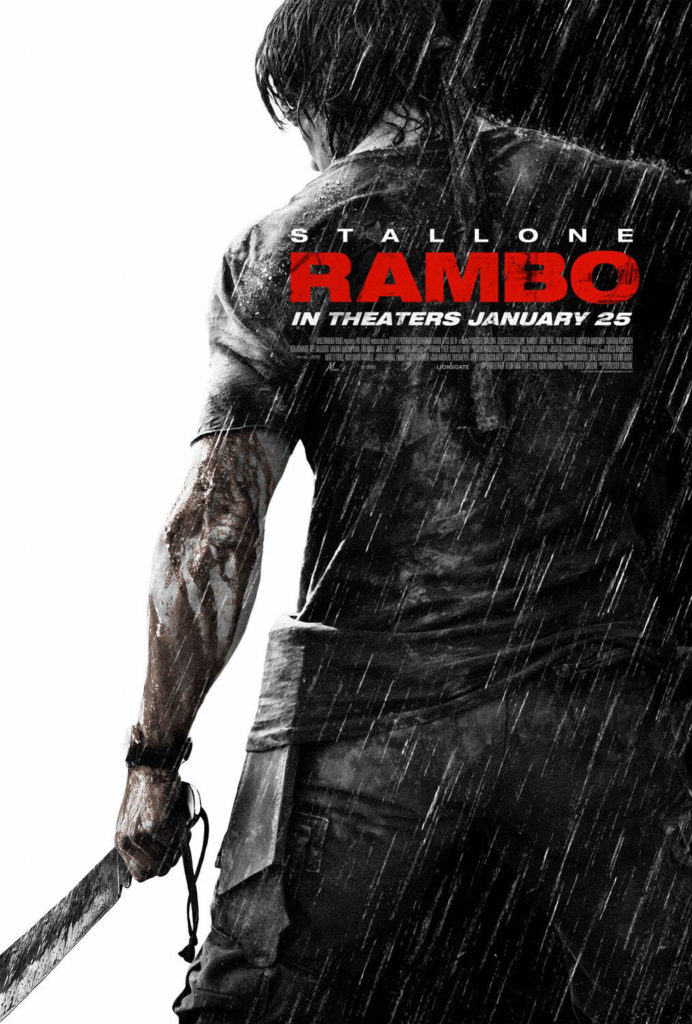2008 was another treat for Sylvester Stallone fans. After the success of Rocky Balboa, it was time to resurrect Sly’s second most popular alter ego. It had been 20 years since the last Rambo movie, and it was a sad end to the series. In the intervening years the Cold War came to a fortuitous close, and Rambo’s Mujahideen buddies from the third flick became America’s enemies. Never mind all that, though. Rambo doesn’t bother with any of America’s bugaboos, past or present. The bad guys in this flick are from Burma.
Following the events of Rambo III, John Rambo (played by Sly, who also directed, and shared screenwriting credits with Art Monterastelli) appears to have found a life of peace in middle-of-nowhere Thailand. At least, that’s the impression one gets from Rambo’s introduction. He’s still wound tighter than a golf ball but at least he isn’t beating up locals with sticks in this film. Rather, he’s got a boat. He might even be a fisherman — but it looks as if most of his income comes from catching snakes.
One day, along comes a group of Christian missionaries from the States. They are led by Michael (Paul Schulze) and Sarah (Julie Benz). They want to hire Rambo to take them upriver into war-torn Burma so they can provide medical care to villagers caught up in Burma’s ongoing civil war. It’s brutal work, and Rambo is rightfully reluctant to escort the missionaries to their certain deaths. But a plea from Sarah cinches the deal, and Rambo fires up the boat. All is going well for the missionaries, but one bad day is all it takes to see the missionaries nabbed by the Burmese army. These baddies show up in the village to kill everyone who isn’t central to the plot, while taking everyone else back to a jungle  encampment. Back in Thailand, Rambo learns of the fate of the missionaries from their pastor (Ken Howard). There’s some handwringing and some soul searching, but of course Rambo makes the decision to head back upriver for a rescue. Only, he won’t be going alone. Accompanying him will be a band of mercenaries hired by the pastor. In fact, Rambo’s job is to give them a ride upriver, and that’s it. He’s not expected to jump into the fight.
encampment. Back in Thailand, Rambo learns of the fate of the missionaries from their pastor (Ken Howard). There’s some handwringing and some soul searching, but of course Rambo makes the decision to head back upriver for a rescue. Only, he won’t be going alone. Accompanying him will be a band of mercenaries hired by the pastor. In fact, Rambo’s job is to give them a ride upriver, and that’s it. He’s not expected to jump into the fight.
If a viewer thought Rambo was annoyed by the missionaries, that’s nothing compared to how much the mercenaries get on his nerves. They are led by a former SAS operator named Lewis (Graham McTavish), who can’t keep his mouth shut for the entire time he’s on screen. He may have been SAS, but he plays the arrogant opposite of the stoic Rambo. There’s no way this film could finish without Lewis getting his comeuppance.
Back in Burma, Sly and the mercenaries find the captured missionaries, igniting a wave of graphic violence that is horrific in its depiction, but cartoonish in its scale. This is clearly the result of the increase in realistic war violence pioneered by Saving Private Ryan, but it’s also fetishistic. No matter how righteous Rambo’s cause, and no matter how the horrific nature of the violence fits into the narrative of Rambo as a lifelong victim of war, it’s still a cartoon — but repulsive in a way 1980s action films never thought to try.
The intervening decades between Rambo III and Rambo saw many changes to the action genre. Much of what was acceptable to audiences in the ’80s became laughable by the late ’90s. Not only have we come to expect greater realism from the films we watch (a process that has been ongoing since the advent of motion pictures), the 21st century has done much to inure us against anything but extreme depictions of violence. There’s something to be said there about a loss of innocence, perhaps, but I prefer to think it’s a reflection of hard-won awareness of the horrors of war. Remember, when this film was released the nation was weary of war from years of fighting in Afghanistan and Iraq. Just as it’s impossible to separate the first film in the Rambo series, First Blood, from America’s experience in Vietnam, it’s impossible to separate this film from our experience with the war on terror, despite it being set in a country where we haven’t fought since World War II.
Yet, this film is also kin to First Blood in that it speaks to its audience on a visceral level. That’s something Rambo: First Blood Part II and Rambo III never tried to do. Those flicks were pure action schlock. First Blood and Rambo are reactions to the world in which we live. That makes Rambo much more of a direct sequel to First Blood, rather than the other two films. Rambo is a good movie, and it demands examination of war in much the same way that First Blood did.
